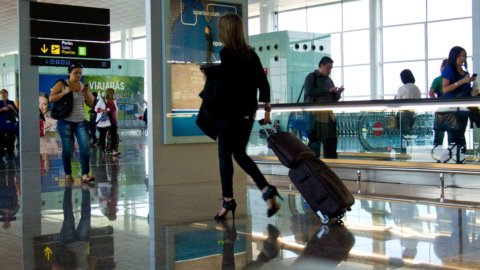Yesterday the President of Toscana Aeroporti, Marco Carrai, the Vice President, Roberto Naldi, and the Chief Executive Officer Gina Giani presented the project to expand the Pisa airport terminal and the flight infrastructure connected to it in the scope of the 2018-2028 Master Plan.
In continuity with the presentation of the terminal expansion project which took place last July 2018, today was an opportunity to present the detailed projects and the integration of the 2018-2028 Master Plan as a whole, meaning by it the program of interventions relating to the broader infrastructural system that gravitates around the Pisa airport, from the secondary runway to the parking areas, up to the forecast for the construction of an aircraft maintenance hub.
The 2018-2028 master plan – for which the terminal expansion project represents the most significant work both in terms of expected investments and in terms of impact on the management of traffic growth and services offered to passengers – has therefore been integrated and updated in the light of the infrastructural and operational needs and criticalities dictated by sharing the airport with the air force, which the airport belongs to.
The interventions envisaged on the flight infrastructures will concern the Echo link and the secondary runway, currently used only for taxiing, the extension of the apron area (Apron) in line with updated needs and the construction of an aircraft maintenance HUB which envisages an infrastructural development in the North-East area of the military airport grounds.
As far as interventions on passenger infrastructure are concerned, the project to expand the Pisa terminal provides for the implementation of a first phase of interventions - for an investment of 37 million euros - with the aim of increasing the airport capacity up to 6,5 million passengers per year and the total area from 35.900 to 63.800 m16 with an increase in: gates (from 23 to 8), security gates (from 10 to 2.300) and commercial areas (+XNUMX mXNUMX).
In detail, the relationship between the terminal and aircraft aprons, the volumetric and compositional balance of the terminal, the flows and paths of passengers and consequently their experience, the safety conditions will be improved by separating the flows of boarding from the perimeter roads , the possibility of managing two intercontinental flights at the same time, the addition of any additional fingers, the expansion of the baggage reclaim area and, lastly, the circulation of ramp vehicles.
Today's meeting was also an opportunity to take stock of a record 2018 in terms of passenger traffic at Toscana Aeroporti and at the two airports of Pisa and Florence.
For the first time, 8 million passengers were exceeded: in 2018 Toscana Aeroporti in fact recorded a passenger growth of 3,7%: 8 million and 182 thousand passengers passed through the two airports.
Pisa Galileo Galilei Airport Pisa recorded 2018 million passengers in 5,5, with an increase of 2017% compared to 4,4. The increase is mainly attributable to the trend in movements (+3%) and in the load factor which stands at an average value of 87,1% (+0,5%). Cargo traffic is also growing, with 11,5 thousand tons of goods and mail registering an increase of 8,7%.
Florence Amerigo Vespucci Airport Florence recorded growth of 2,3%, with 2,7 million transiting passengers in 2018. Results mainly due to the increase in the capacity of the aircraft used at the Florence airport and the growth of the load factor (+0,8. 3,6%) which more than offset the decrease in movements (-XNUMX%).
The growth of the two airports is yet another proof of the validity of the Toscana Aeroporti project, the clear differentiation of the market segments of the two airports and the solidity of the Tuscan airport system as an integrated network.
Finally, during the meeting, the strengthening of the partnership with Ryanair, the first European airline in terms of number of passengers transported per year, was announced. The partnership, started in 1998, was confirmed and strengthened thanks to the signing of a new 2023 agreement, creating the conditions for the development of traffic and new destinations departing from the Pisa airport.
MASTER PLAN 2018-2028 PISA AIRPORT: DETAILS ON THE PROJECTS
The 2018-2028 Masterplan of Pisa airport has been integrated and updated in the light of the infrastructural and operational needs and criticalities dictated by sharing the airport with the Air Force, which the airport belongs to.
In order to implement the Masterplan and make the airside and landside systems coherent, it was necessary to develop an integrated and parallel design of works in both areas.
In particular, the areas of intervention concern:
Flight infrastructures: – Interventions on the Echo link with deep pavement requalification; – Interventions on the secondary runway, currently used only for taxiing, with the aim of obtaining STRIP adaptation and upgrading, creating a new water drainage system and restoring the runway body flooring; – Interventions relating to the expansion of the parking area (Apron) in line with the updated needs which provide for the rectification of the boundaries of the former village of via Cariola and interventions on the so-called ramp 0; – Provision for the construction of an aircraft maintenance HUB which envisages infrastructural development in the North-East area of the military airport grounds;
Passenger infrastructures: – Upgrading of operational units for passenger processing and service levels – Terminal expansion, details below:
The Pisa terminal expansion project provides for the implementation of a first phase of interventions to increase the terminal's airport capacity up to 6,5 million passengers per year. At the end of this first phase, the total surface area of the terminal will increase from 35.900 to 63.800 m16 with an increase in: gates (from 23 to 8), security gates (from 10 to 2.300) and commercial areas (+XNUMX mXNUMX).
The first phase of the works involves an investment of 37 million euros and is part of the broader program of interventions which will see further development of the terminal (the so-called "Phase 2") with an increase in surface area, the number of check-in desks and of the gates.
With the completion of the works envisaged in the first phase, Galilei airport will be able to handle the growth of air traffic with high levels of services, improving the management of incoming and outgoing passenger flows. In particular, the relationship between the terminal and the aircraft aprons will be improved, the volumetric and compositional balance of the terminal, the flows and routes of passengers and consequently their experience, the safety conditions by separating the flows of boarding from the perimeter roads, the possibility of managing two intercontinental flights at the same time, the addition of any additional fingers, the expansion of the baggage reclaim area and, lastly, the circulation of ramp vehicles.
The increase in the areas to be used for food & retail activities will allow a redefinition of the commercial offer of the Galilei airport, with consequent benefits in terms of non-aviation revenues, and the adaptation of the technological systems will be carried out with a view to environmental compatibility and efficiency energy, in line with the highest European standards, also in terms of safety.
In July 2018, the expansion works of the so-called "Phase 0" were completed in order to guarantee the maintenance of adequate levels of service in consideration of the increase in passenger traffic recorded.
More specifically, the interventions concerned two distinct functional areas: i) the increase of the surface area by 32% of the non-Schengen departure hall located on the first floor in the western area of the terminal and the construction of 1 boarding gate, 170 seats and a dedicated children's area, ii) the 47% extension of the arrivals hall on the ground floor located in the east area of the terminal and the new baggage carousels.
The blocks dedicated to toilets have also been expanded with the doubling of capacity, both in the arrivals area and in the departures area.
A children's area has also been created in the non-Schenghen area, the friendly lounge has been renovated for passengers with special needs and the priority lane has been opened for business and priority passengers.





